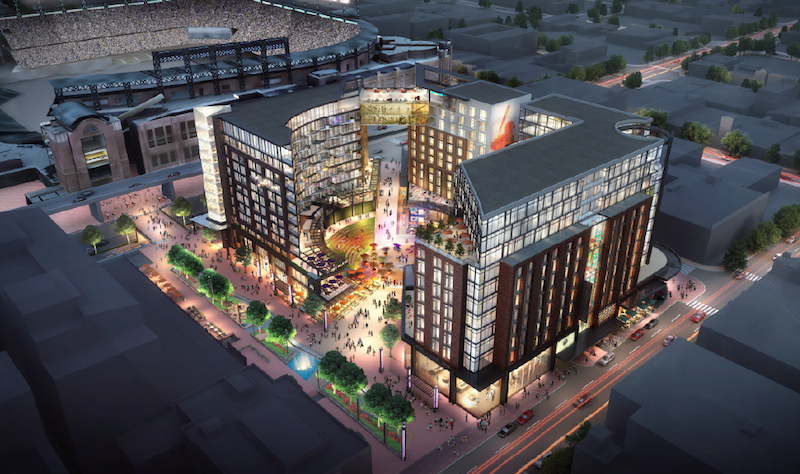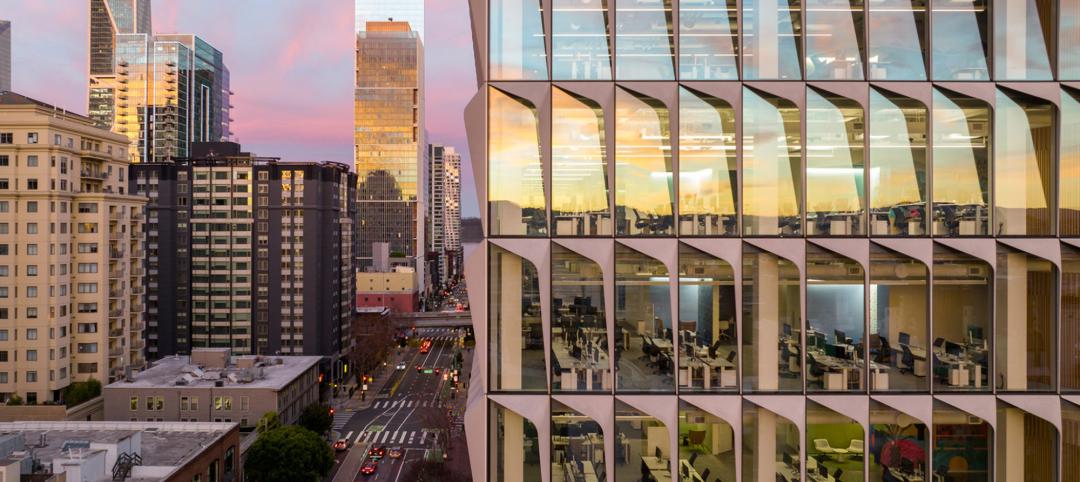Sports arenas and stadiums continue to be the stimuli for urban reincarnations.
Stantec has several sports “district” projects underway in Dallas, Tampa, Chicago, and Edmonton. In Denver, the firm is proposing to transform a parking lot near Coors Field, home to the Colorado Rockies baseball team, into a mixed-used environment across an entire city block. Offices would account for half of the total square footage, which would include spaces for hospitality, residential, retail, entertainment, and food and beverage.
The proposal for this three-acre project, which is entering its entitlements phase and should start construction next year, would include a new Colorado Rockies Hall of Fame facility and an outdoor “content plaza,” which beyond serving as a pre- and post-game gathering place for fans, would function year-round as a space for concerts, festivals, and other activities, complete with restaurants and A/V systems.
The Building Team includes architect RNL (part of Stantec) and Hensel Phelps (GC). The baseball team is the developer and the Stadium District owns the land, which is the last open parcel connected to Denver’s LoDo district, Union Station, and RiNo district.
As part of the major Wrigleyville investment around Wrigley Field in Chicago, Stantec designed new exteriors for the field, and is lead designer for the new boutique Hotel Zachary.
In Minneapolis, the general contractor Ryan Companies played a central role in transforming a ramshackle downtown area that was mostly parking lots into office and residential space located near the 70,000-seat U.S. Bank Stadium, which opened in 2016 and, on February 4, will host Super Bowl LII.
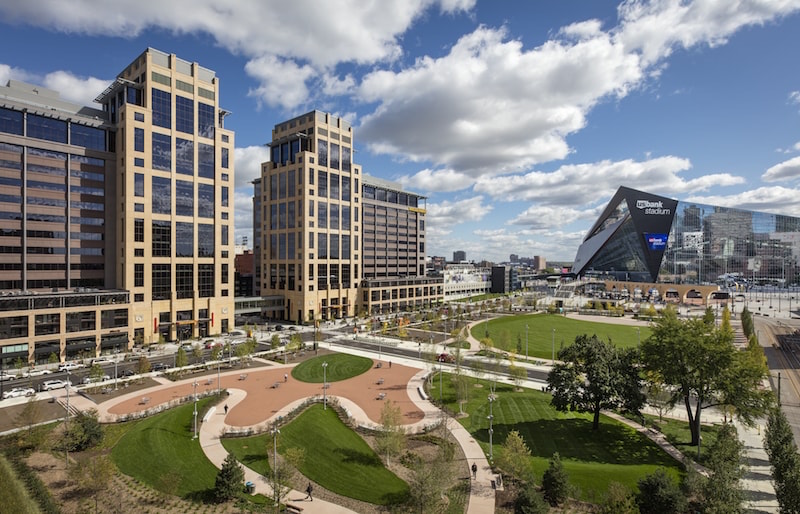 The city of Minneapolis has converted five barren blocks near U.S. Bank Stadium into a vibrant destination that includes two parks, office and residential buildings, and restaurants and retail. Image: Paul Crosby/Courtesy of Ryan Companies
The city of Minneapolis has converted five barren blocks near U.S. Bank Stadium into a vibrant destination that includes two parks, office and residential buildings, and restaurants and retail. Image: Paul Crosby/Courtesy of Ryan Companies
This project dates back to 2012, when the Minnesota Legislature approved funding for a new stadium for the Minnesota Vikings professional football franchise. The site chosen for that stadium was the former site of the Hubert H. Humphrey Metrodome, where the Vikings played from 1982 until it closed in 2013.
That site is adjacent to five city blocks that the Minneapolis Star-Tribune owned at the time. On these parcels, the newspaper’s headquarters and printing facilities were surrounded by surface parking and not much else.
In an effort to significantly upgrade this area, Mayor R.T. Rybak brought together the Tribune, Wells Fargo, and Ryan Companies to devise a redevelopment plan.
What they came up with now includes a 1.28-million-sf, $300 million, two-building complex into which Wells Fargo in 2016 moved 5,000 employees who previously had been working in nine different buildings in the downtown area. The towers represent the third-largest LEED Platinum-certified complex in the world, and the largest in the U.S.
The Downtown East Project, as it is known, added 4.2 acres of parkland over two blocks known as Downtown East Commons (Hargreaves Associates was the landscape architect), a 1,160-slot parking garage, a 164-key Radisson Red hotel, 31,000 sf of retail space, another multi-tenant office building, and the 195-unit Edition Apartments, 120 units of which face the park and street (The Tribune moved its printing to the suburbs, and downsized its headquarters in 2015 to a nearby office complex.)
The redeveloped area is along city’s light-rail system, and connects to Minneapolis’ indoor skyway that spans this metro.
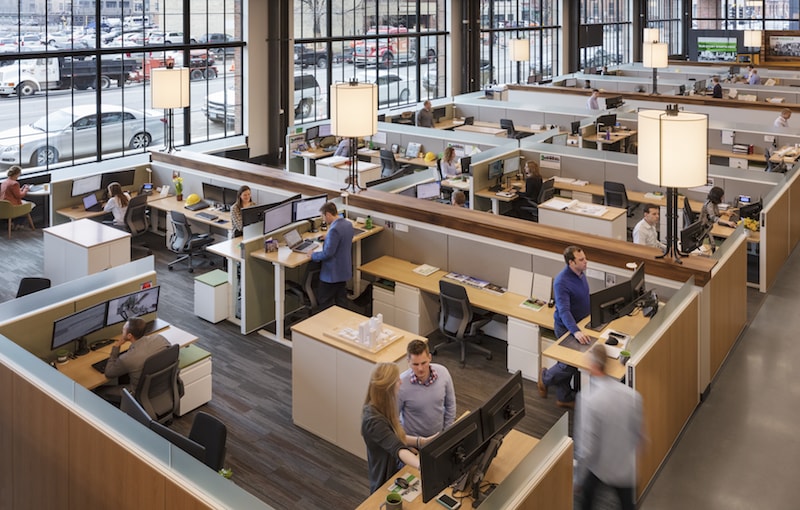
Ryan Companies, the general contractor on the Downtown East project in Minneapolis, is leasing the first two floors of the Millwright Building within that redevelopment for 300 of its employees. Image: Paul Crosby/Courtesy of Ryan Companies
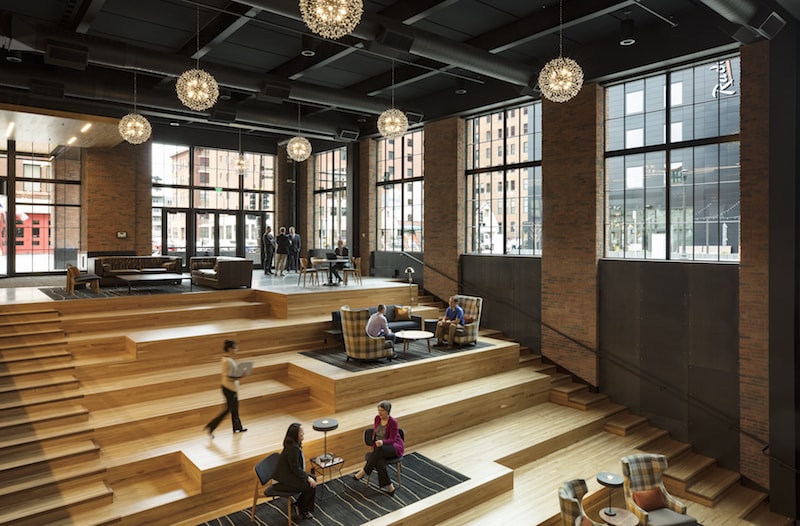
A sunken wooden lobby is an amenity for Ryan Companies' employees and a space-saving solution for the Millwright Building. Image: Paul Crosby/Courtesy of Ryan Companies
Last April, Ryan Companies moved 300 of its 1,200 employees into the new 190,000-sf Millwright building, another piece of the Downtown East Project. The company currently uses 65,000 sf within the first two floors. It is leasing the third and fourth floors for the Super Bowl. Ryan also owns the air rights over the parking garage, which can support a 20-story building, according to Josh Ekstrand, AIA, NCARB, Ryan’s Director of Design.
Ryan Companies US was the general contractor for the entire project. A wholly owned subsidiary, Ryan Architecture + Engineering (A+E), was the design architect for the exterior and AOR for the core and shell of the Wells Fargo towers. RSP designed the towers’ interior core spaces, and Perkins + Will was the interior architect for the towers’ office floors.
Ryan A+E was designer and AOR for the Edition apartments, whose interiors were designed by ESG. Ryan A+E also was design architect, AOR, and interior and core-and-shell design for its offices in Millwright.
Ryan A+E was design architect on the parking garage (RSP was AOR), and design architect and AOR on the Skyways. ESG was design architect and AOR on Radisson Red.
The city of Minneapolis, which paid for the project with $62 million in bond financing, estimates that Downtown East will generate $14.1 million in new property taxes in 2018, of which $3.2 million will accrue to the city.
Related Stories
Urban Planning | Jul 24, 2023
New York’s new ‘czar of public space’ ramps up pedestrian and bike-friendly projects
Having made considerable strides to make streets more accessible to pedestrians and bikers in recent years, New York City is continuing to build on that momentum. Ya-Ting Liu, the city’s first public realm officer, is shepherding $375 million in funding earmarked for projects intended to make the city more environmentally friendly and boost quality of life.
University Buildings | Jun 26, 2023
Addition by subtraction: The value of open space on higher education campuses
Creating a meaningful academic and student life experience on university and college campuses does not always mean adding a new building. A new or resurrected campus quad, recreational fields, gardens, and other greenspaces can tie a campus together, writes Sean Rosebrugh, AIA, LEED AP, HMC Architects' Higher Education Practice Leader.
Urban Planning | Jun 15, 2023
Arizona limits housing projects in Phoenix area over groundwater supply concerns
Arizona will no longer grant certifications for new residential developments in Phoenix, it’s largest city, due to concerns over groundwater supply. The announcement indicates that the Phoenix area, currently the nation’s fastest-growing region in terms of population growth, will not be able to sustain its rapid growth because of limited freshwater resources.
Mixed-Use | Jun 6, 2023
Public-private partnerships crucial to central business district revitalization
Central Business Districts are under pressure to keep themselves relevant as they face competition from new, vibrant mixed-use neighborhoods emerging across the world’s largest cities.
Urban Planning | Jun 2, 2023
Designing a pedestrian-focused city in downtown Phoenix
What makes a city walkable? Shepley Bulfinch's Omar Bailey, AIA, LEED AP, NOMA, believes pedestrian focused cities benefit most when they're not only easy to navigate, but also create spaces where people can live, work, and play.
Urban Planning | May 25, 2023
4 considerations for increasing biodiversity in construction projects
As climate change is linked with biodiversity depletion, fostering biodiverse landscapes during construction can create benefits beyond the immediate surroundings of the project.
Urban Planning | Apr 17, 2023
The future of the 20-minute city
Gensler's Stacey Olson breaks down the pros and cons of the "20-minute city," from equity concerns to data-driven design.
Urban Planning | Apr 12, 2023
Watch: Trends in urban design for 2023, with James Corner Field Operations
Isabel Castilla, a Principal Designer with the landscape architecture firm James Corner Field Operations, discusses recent changes in clients' priorities about urban design, with a focus on her firm's recent projects.
Sustainability | Apr 10, 2023
4 ways designers can help chief heat officers reduce climate change risks
Eric Corey Freed, Director of Sustainability, CannonDesign, shares how established designers and recently-emerged chief heat officers (CHO) can collaborate on solutions for alleviating climate change risks.
Urban Planning | Mar 16, 2023
Three interconnected solutions for 'saving' urban centers
Gensler Co-CEO Andy Cohen explores how the global pandemic affected city life, and gives three solutions for revitalizing these urban centers.


